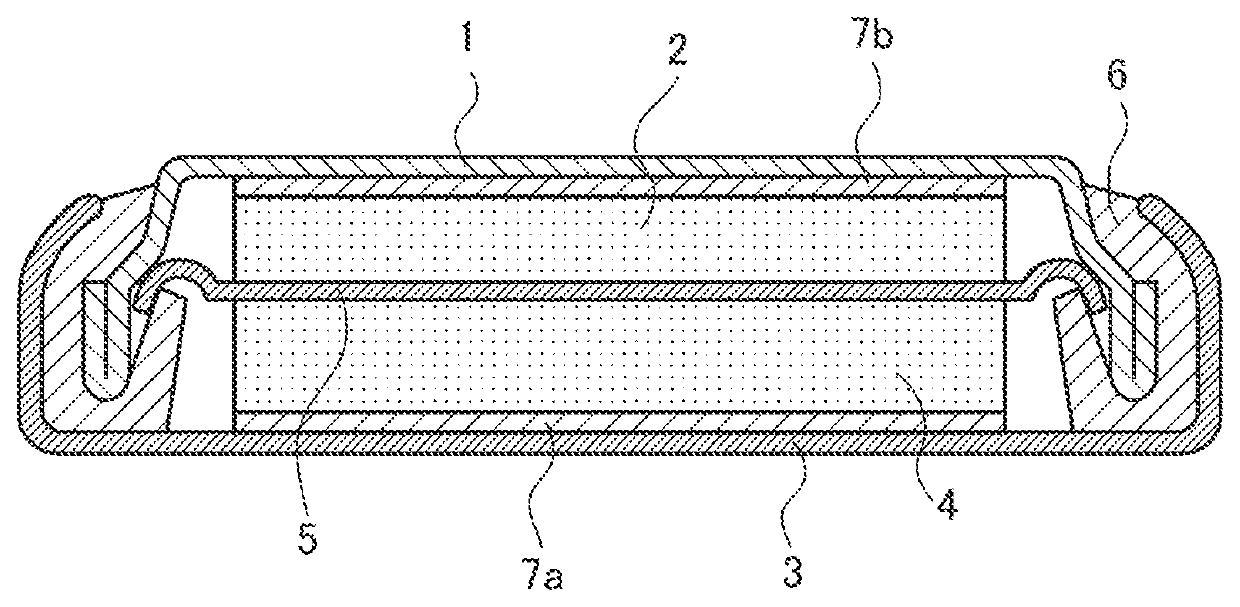Method for producing carbonaceous substance-coated graphite particles
a carbonaceous substance and graphite technology, applied in the direction of active material electrodes, cell components, electrical apparatuses, etc., can solve the problems of insufficient battery properties, such as initial charging-discharging efficiency and cycle characteristics, and achieve excellent battery properties
- Summary
- Abstract
- Description
- Claims
- Application Information
AI Technical Summary
Benefits of technology
Problems solved by technology
Method used
Image
Examples
example 1
>
[0139]To 100 parts by mass of spherical natural graphite particles (particle diameter D50: 10 μm), 8.0 parts by mass of a xylene-modified novolac-type phenolic resin A pulverized into a powder form by means of an impact mill (available from Sumitomo Bakelite Co., Ltd., particle diameter D50: 34 μm, unmodified ratio: 0.72, weight average molecular weight: 19,800, residual carbon ratio: 34 mass %) was added, followed by mixing at 25° C. for 15 minutes using a drum-type mixer, whereby resin-adhered graphite particles were obtained.
[0140]The obtained resin-adhered graphite particles were put in a graphite container having a lid and heated with nitrogen flowing at 2 L / min (in a non-oxidizing atmosphere) at 1,200° C. for three hours using a tubular furnace, whereby carbonaceous substance-coated graphite particles were obtained.
[0141]Each of the physical properties of the obtained carbonaceous substance-coated graphite particles was determined according to the foregoing methods. The resul...
example 2
[0157]Carbonaceous substance-coated graphite particles were prepared in the same manner as in Example 1 except that an amount of the xylene-modified novolac-type phenolic resin A added with respect to 100 parts by mass of spherical natural graphite particles was changed to 5.0 parts by mass, and were evaluated. The results are shown in Table 1 below.
example 3
[0158]Carbonaceous substance-coated graphite particles were prepared in the same manner as in Example 1 except that an amount of the xylene-modified novolac-type phenolic resin A added with respect to 100 parts by mass of spherical natural graphite particles was changed to 1.5 parts by mass, and were evaluated. The results are shown in Table 1 below.
PUM
| Property | Measurement | Unit |
|---|---|---|
| pore specific surface area SAa | aaaaa | aaaaa |
| pore sizes | aaaaa | aaaaa |
| pore sizes | aaaaa | aaaaa |
Abstract
Description
Claims
Application Information
 Login to View More
Login to View More - R&D
- Intellectual Property
- Life Sciences
- Materials
- Tech Scout
- Unparalleled Data Quality
- Higher Quality Content
- 60% Fewer Hallucinations
Browse by: Latest US Patents, China's latest patents, Technical Efficacy Thesaurus, Application Domain, Technology Topic, Popular Technical Reports.
© 2025 PatSnap. All rights reserved.Legal|Privacy policy|Modern Slavery Act Transparency Statement|Sitemap|About US| Contact US: help@patsnap.com



